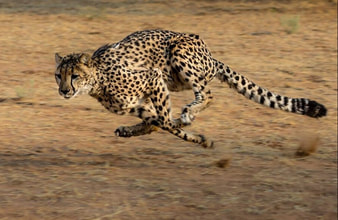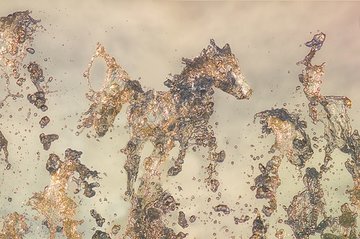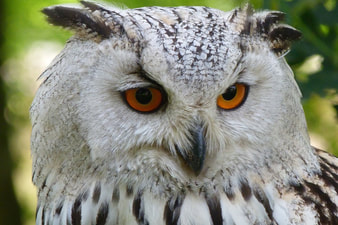 What? Already? But I just started learning and it doesn't seem to be working yet! Communication is a two-way street. Animals are already masters at this, so they are sending you information all of the time, even if you don't recognize it as that. Maybe that "intuitive sense" you have about what an animal needs or wants is not coming from you, but from the animal — and you are intuitively picking it up! No, it may not sound like a typical conversation, but it's communication nonetheless. Further, animals are also always picking up messages that you unconsciously send — which means at some level, you already know how to do this. With that in mind, start consciously sending messages to the animals around you. And consciously listen for them. Since you're probably already communicating, you might as well be aware of it and enjoy the process!
2 Comments
Just Keep Swimming! So there you are, holding your breath after having a conversation with an animal, and waiting for what the pet parent will say. Did you get it all wrong? Were you spot on? Should you feel embarrassed or proud or accomplished? UK animal communicator, Joanne Yeoh, says forget all of that. "After doing an animal communication reading, don't wait until you get feedback before doing the next one. Just move on!" Her reasoning makes perfect sense: it's easy to set up blocks in your mind based on assumptions, the kind of feedback you get, and even the style in which it's delivered. There are always many variables. Each animal will create a different experience for you, so it won't be the same as the last anyway, no matter what the feedback. And even if a pet parent thinks you got something wrong, it's not necessarily true. But feedback like that can shut down your clear and open abilities. So keep the momentum going. With every conversation, your results and abilities become clearer — especially without those mind-created stumbling blocks along the way.  Somewhat different than the legendary 5-Second Rule, which magically keeps that food you dropped on the floor perfectly clean and sanitary to eat, the 3-Second Rule in animal communication urges you to accept whatever comes to you in the first few seconds of connecting or asking a question. After that, your brain kicks in and tries to interpret and create stories around what you are experiencing — and those explanations are almost always inaccurate. The Three-Second Rule is based on extensive research done in secret for years by the U.S. government in their effort to create an army of telepathic spies. Though it sounds pretty sci-fi, their approach was actually scientific and involved studying actual psychics to learn their techniques and processes. So, trust your initial impressions. You are likely more accurate than you think.  How do you feel about someone who is brusk, rude, unaware, self-focused? Probably wouldn't want to spend much time with such a person, right? As loving as animals can be, they often feel the same way! So when we nervously or enthusiastically or anxiously "burst" into an animal's world through a telepathic heart connection — no matter how nice and respectful we normally are as people — it's easy to forget about manners and how the animal might be perceiving things. After all, if someone jumped out of thin air into your personal space and started peppering you with questions, you also might be surprised, afraid, irritated, angry, confused, or any number of other less-than-ideal feelings. A polite conversation begins with consent on both sides. Introduce yourself. Ask if this is a good time or if they are interested in speaking with you — and perhaps mention a possible topic or two. Animals are sentient beings who appreciate this formality, opportunity, and courtesy. If the energy feels right to them, your approach feels respectful, your personality to their liking, you'll start things off on the right foot. If it's not the right time or match-up, perhaps check back another day or take a closer look at how you are presenting yourself.  Many people are able to let down their guard or feel comfortable showing their real selves when at home, among good friends or close family, or in a familiar environment. Writers, artists, and even meditators use this concept by creating a dedicated place for thinking and connecting to inspiration. Having a routine in a regular spot with familiar surroundings can more quickly put your mind at ease, making things like animal communication so much easier. This is part of the idea of finding your own Sit Spot — a happy space, often out in nature, where you can simply sit, be, observe, heighten your senses, and connect more fully with your surroundings. Donna Brickwood takes you through the easy steps to establishing such a routine in this short video. As your skills and confidence grow in doing this, you will likely graduate to being able to connect just about anywhere at anytime. But if you are just beginning and are still finding your way, maybe creating a personalized incubator is your perfect first step.  Trusting what you see, hear, feel, and sense is one of the biggest challenges in animal communication. But how do you build that faith in what you are perceiving when there are so many variables, unknowns, contrasting messages from other communicators, and ways you could be wrong? The answer, according to John Friedlander and Gloria Hemsher, in their book Basic Psychic Development, is to validate your perceptions. Not through an external source, like by asking the people connected with the animal. But internally. When you validate an emotion, an energy, a perception, or interpretation, you are allowing your body to say, "This is what exists now according to what I am feeling or sensing." It doesn't necessarily mean these perceptions are true, but it acknowledges they are currently yours — and that they could change in the next moment. And when you acknowledge this fluid state of reality, you can let go of feeling like what you produce must be unyieldingly set in stone, and therefore, correct for all time. You can freely move forward, knowing that your perceptions and interpretations are real and valid. Yes, they may shift in the next minute when you learn something new and adjust your previous interpretation to a new understanding. But the awareness of this fluidity is what sets you free.  One of a learning animal communicator's major enemies is the pressure to perform; to produce results. It can lead to such anxiety that clarity goes out the window and the mind goes blank. However, a small shift in approach can help you avoid this trap. Biofeedback pioneers, Elmer and Alyce Green, coined the phrase passive volition to describe this shift. When faced with a task like animal communication, the mind thinks it needs to produce results at all costs and stays in active mode. It's similar to someone who is nervous in a social situation and so keeps on mindlessly talking rather than listening. To solve this, the Greens recommend actively clearing the mind first so that you can passively receive information. This effectively removes you from the responsibility of producing results. Researcher, Kenneth Batcheldor, also found the major impediment to psychic ability was this ownership inhibition — when people feel they are personally responsible for making things happen. When people worry about personal failure, their psychic abilities drop. When they believe they are not in control of the outcomes, their scores improve. This is why people have such success with methods that take the responsibility out of their hands, like crystal balls, tarot cards, and even calling in help from angels. Helen Palmer, founder of the Center for Investigation and Training of Intuition, agrees and recommends using an inanimate object, like a rock or leaf, to give you the information. Maybe your pet rock has a new purpose in life?  When it comes to acknowledging our successes in animal communication, our minds tend to have a short-term memory. Add to that, we also often focus on what we didn't get right, rather than what we did. It's a recipe for frustration and deflated confidence and self-esteem. But there's hope! You can outsmart your own brain simply by keeping a journal of your animal communication sessions. It can be as simple as noting fuzzy impressions, feelings, or colors, to recording full conversations. Now here's the important part, recommended by well-known animal communicator, Carol Gurney, in her book The Language of Animals: 7 Steps to Communicating with Animals: after asking for validation or feedback from the animal's people, go back to your journal and highlight everything you got right. Even if it's just a little bit right. Your mind won't be able to go back and "change history" when you have this kind of proof of progress. But Carol says, don't stop there. "Think back to how it felt, to what you were doing, when you got those things right or wrong. Were you in your head? In your heart?" Don't let your mind sweep these clues under the rug. With a little sleuthing, you may discover that you are making progress; that you are more successful at this than you ever thought! Do you already write a diary or blog about your learning experiences? Speak! Good Human. can help you help other students learn from your journey. See our Student Journals page for more details.  The brain is capable of incredible things. Unfortunately, those things don't always work in your favor. Experts point to an example they call secondary elaboration, which is the mind's tendency to make assumptions, interpretations, and elaborations above and beyond your initial first impressions. While this can be useful sometimes, it can lead to getting way off course when it comes to things like animal communication. The HeartMath Institute has done extensive studies on this phenomena and recommends synchronizing your brain with your heart for a much more balanced, grounded, and accurate experience. By "breathing" from the heart while focusing on emotions of love and gratitude (which they call the Quick Coherence Technique), you entrain your brain and other body parts to your heart center and its unique frequency. And from this calmer, more loving space, you can not only "speak and hear from your heart," but connect with animals in the way they already do. And, of course, that's what we're all striving for, aren't we?  Many of our blocks and difficulties using our sixth sense, telepathy, and even intuition stem from our unconscious minds. This is the part (and scientists say it's 95-99% of our thinking) that runs on autopilot just beneath the surface and is often driven by all the fears, anxieties, pain, negative-speak, misinformation, and traumatic experiences we've had since we were little. If left alone, it runs without our input or control! There are ways to clean up your unconscious mind, of course, but another strategy is to simply expand your conscious mind so you are much more in control of your life. Thinking consciously, it turns out, also lets you see and hear things you couldn't before. And that includes telepathing with animals, plants, elementals, and more. Spiritual teacher and author, Michael Roads, teaches this quest to becoming more conscious and being able to communicate and commune with nature and suggests this exercise: Go out to the garden or a natural space, rope off 5 or 10 yards, sit in the middle with a notebook and write down everything you see in this area. Do this everyday and you will begin to notice things you didn't at first. You will realize that what looked like a patch of park or forest that seemed unchanging from day to day, was actually filled with newness and change — always evolving in every moment. When you begin to notice all of this newness in your space, all the unseen details, you're starting to think more consciously and in the moment. And that's where nature spirits, animals, and everyone but humans, live. Hope and desire can only get you so far. Why not see what a dramatic change in thinking can do for your animal communication and interactions with our natural world?  Honing your psychic abilities and tapping into your capacity to communicate with animals is all about reawakening your latent power and learning how to use it again. And you may already be having more success than you realize! That's why prominent psychotherapist and author Belleruth Naparstek suggests in her book, Your Sixth Sense, that being able to identify ways you are already succeeding is one of the key first steps to further awakening your skills. She cites a study by Puthoff and Targ that included coaching regular (apparently non-psychic) people to pay attention to certain psychic clues when doing a remote viewing exercise. Within a couple of hours, these "regular" people became as proficient at remote viewing as those in the control group — those already recognized as psychic. Wow! So, what are the psychic clues to look for? According to the study, paying attention to first impressions, spontaneous and surprising impressions, multi-sensory impressions (as opposed to merely visual), and emotional impressions, all helped improved accuracy and produce impressive results. Perhaps when you lament that you aren't "getting" this animal telepathy stuff, you are focused on the wrong signs that things are working. What would happen if you put aside your preconceptions and expectations for a moment and instead put your mind on alert for some of the above-mentioned clues? I would love to hear your results!  We all want desperately to deliver a great and helpful message, conversation, or answer to the animal's human. But when just a few hints or clues come in, like an image or word, we may feel like we failed. That's when our brains often jump in to "save the day" by trying to fill in all the missing information to create a full story — even if that information is not at all accurate! This is why experienced communicators implore us to remain messengers, not interpreters. What doesn't make sense or seems incomplete to us, may make perfect sense to the animal's human. So, simply relaying what you get and letting the person actually in the situation interpret it is usually a good rule to follow. However, it's also a good rule to break sometimes! That's because sometimes — actually, often — when you convey information or messages to people, they don't look for those deeper interpretations, but instead immediately judge the superficial information as right or wrong; accurate or inaccurate. Communication isn't always as clear as that! Without looking for the deep meanings and symbolism, we may be missing the important messages (and based on client feedback, feel like we are wrong all the time, as well!). Arthur Myers offers numerous examples of this in his book, Communicating With Animals: The Spiritual Connection Between People and Animals. One perfect story tells of animal communicator, Marlene Sandler's experience. She senses what animals want to say through images, feelings, and impressions — and these often come over as metaphors, a figure of speech rather than a literal translation. One such conversation was with a woman's cats, who had stopped eating, making her very concerned. Marlene got the image of an empty bathtub and the message: you haven't taken a bath. Left to its literal translation, the client might have thought the cats were commenting on her hygiene. But further digging and examining this message divulged the deeper meaning: the cats missed their playtime with the woman as she relaxed after work in a hot bath. She had recently taken a different job which didn't leave time for those baths — and so the cats were longing for their playtime with her. So, even if we as communicators don't know enough about a situation to accurately interpret something, encouraging the animal's human to think more deeply and perhaps look for metaphors or less literal meanings, may lead to more successful communications rather than ending in the short-sighted declaration: "you're wrong!"  Have you heard about the people who help their houseplants thrive by talking lovingly to them? What about the study by Dr. Masaru Emoto in the 1990s that tracked the effects of words, prayers, and music on the crystalline structure of water? The results were amazing. Wondering if you can apply the same principles to your animal communication adventures? Without a doubt. Here's how to start: 1) Before connecting, give yourself an infusion of positivity. Tell yourself, "You can do this. You were born to help animals and give them a voice. You are a brilliant communicator who is simply remembering the skills you already have in you." 2) Now do the same for your animal friend. You can guess how much more receptive he will be after hearing how wonderful he is; how smart and loving; how cherished he is by his human and animal family. 3) Continue this wave of good feelings and positivity in your actual communication. Instead of "Don't dig in my flower garden," try "I would love it if you would dig out by the back fence rather than near my flowers." Positive reinforcement trumps negative any day. You can do this. You were born to help animals and give them a voice. You are a brilliant communicator who is simply remembering the skills you already have in you. I'm positive of it!  The universe is made up of vibrational energy. When you like something or resonate with it, you are interacting at a higher vibration. Most animals already operate at this higher level. So what happens when you try to connect when your vibration is lower — when you are in a bad mood, irritated, tired, or feel doubt, discouragement, frustration, or even failure about your communication abilities? The intended connection becomes a disconnection. This is why so many animal communicators recommend starting with a loving thought about the animal. Offer a compliment. Ask about what they love. Send joy and happiness. This helps you both match your vibrations at a higher level and create more open communication. But you can also take it a step further. Before you even get to the animal, begin with yourself. Throw all that doubt, worry, and insecurity out the window and envision yourself a master communicator who can talk with animals with ease and finesse. When you hold this high vibrational level,, you compel life to rise and match it — to essentially bring you what you believe you already have. In reality, you do already have it and the real trick is believing it.  If you ever had lessons as a kid, you know that part about practicing (and the accompanying nagging) can be a deal-breaker. By the time you reach adulthood, so many people have repeated that tired mantra of practice, practice, practice, that is loses its meaning. Perhaps it's time to rediscover it and make it really work for you in animal communication. You see, what practice is really doing is building muscle memory. At first, learning something like animal communication can be overwhelming as you try and remember all the steps to do this successfully, from grounding and clearing to this skill and that. Then there's the anxiety of getting it wrong. But the more you do these things, the more your body and mind can simply let go and shift to autopilot. That's when the muscle memory takes over, finally freeing you to focus on the finer details, like actually seeing, hearing, and feeling. So ignore your brain when it says don't practice with animals until you know more or reach a certain knowledge level because you may embarrass yourself or take a hit to your ego. Instead, listen to your heart — pure muscle memory — and practice fearlessly every day. Yes, that even means in public with the chance of getting things wrong. Because it's not about right or wrong at this point, it's about getting so comfortable with the process that the anxiety ceases to exist, leaving you with the skill you've been dreaming of having. The best part? You can start practicing now right on this site! |
About these tips...Wouldn't it be great to be able to browse some of the best tips, advice, and methods in animal communication? Sort of like a "greatest hits" album that pulls out the nuggets just for you. That's what this journal is all about — complete with numbered posts to chart the hits along the way. Read More Categories
All
Copyright ©2020 Speak! Good Human. & Josh Coen. All Rights Reserved. Share or republish freely with attribution and link back.
|


